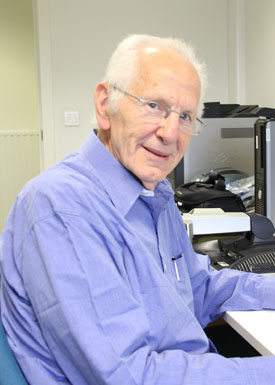Alumni News
What’s Past Is Prologue
Reflections on NIH Alumnus André Van Steirteghem
As my fiftieth anniversary as an NIH scientist nears in this period of stress for NIH and its Intramural Research Program (IRP), I am sometimes reminded of how fortunate I have been to be on the staff of this institution. I am also optimistic that the past can continue to be prologue to the future. And I realize that little of what we do is predictable and, more often than not, any contributions we make are from completely unanticipated developments.

The recent visit of André Van Steirteghem, one of the leaders in the field of in vitro fertilization (IVF) and now an emeritus professor of embryology and reproductive biology at Vrije Universiteit (the Free University) in Brussels, was such an occasion. In December 2013, he came to NIH to deliver a lecture in which he recounted his work in developing and leading the renowned IVF program at the university’s medical school since the early 1980s. His program has been responsible for about 20,000 successful pregnancies. In addition, André pioneered the Intracytoplasmic Sperm Injection (ICSI) technique in which a single sperm is injected directly into an egg.
Before he ever got into the IVF business, he trained at NIH (in the 1970s) in something quite different and, even though I have been immersed in hemoglobin research for almost 40 years, I was his prime mentor. André had come to the Clinical Center from Brussels as a fellow to work in the clinical chemistry department with Mark Zweig. They decided to use radioimmunoassays to measure plasma concentrations of the muscle and brain creatine kinase isoenzymes for improving the diagnoses of cardiac and other diseases. Not only were such assays relatively novel then, but also André and Mark had little knowledge of the needed protein purification, immunological, and labeling techniques to develop them.
That’s where I came in. I was a newly minted protein chemist—having worked for a decade with Christian Anfinsen (who was a co-recipient of the Nobel Prize in Chemistry in 1972 for his work on protein folding)—on top of my medical training. With informal permission from my bosses, who did not understand the relevance of this project to my primary work, I found André an old desk that fit into one of my small laboratory rooms and we started some classical, but inelegant, purification procedures.
Although we succeeded in our goal of developing the assays and published several papers about them, several other groups beat us to publication. However, when André returned home to Brussels in 1977, the physicians in his university’s obstetrics and gynecology department were very happy with his new expertise and hired him to develop radioimmunoassays for use in fertility studies.
In July 1978, Robert Edwards and Patrick Steptoe in England announced the first successful use of IVF that culminated in the birth of a healthy infant—Louise Brown. André and his colleagues soon journeyed to England, as well as to IVF centers in other countries, to learn the details of the methods used. In 1983, with André as the laboratory director of the newly created Brussels IVF center, the first IVF child was born in that facility.
I sometimes think that André has accomplished more direct benefits for humankind than any other person with whom I had the privilege to work during my long stay at NIH. André’s training at NIH certainly provided a foundation that helped to launch his career even though it took off in a very unexpected direction.
Are there important lessons to be learned from this happy happenstance? As one who contributed to the NIH booklet “A Guide to Training and Mentoring in the Intramural Research Program,” I have been long concerned with such questions and I think the answer is “Yes.” First, contrary to what is commonly expected, few trainees will, or should, follow in the narrow pathway of their mentors with regard to the questions to be asked and the methods to be used.
Second, the ultimate utility of any research project or program is often in fields that are quite different from what was planned and anticipated. Third, the research “focus” that review committees often demand may not be ideal for making true advances within the arena of health research.
Fortunately, the IRP has a tradition of fostering an environment that allows scientists to take risks that include venturing outside of their fields. Furthermore, research organizations flourish when there’s continuous interaction among investigators from many disciplines and institutions.
It’s my hope that with NIH’s resources and enlightened leadership—human and technical, basic and applied, clinical and scientific, immediate and long-term—the IRP can and should continue to help spawn major new medical advances in the years ahead.
Alan Schechter, who came to NIH in 1965 as a research associate, is chief of the Molecular Medicine Branch of the National Institute of Diabetes and Digestive and Kidney Diseases. His scientific interest is in developing treatments for the genetic diseases of hemoglobin: He and his colleagues have contributed to the understanding of the pathophysiology of sickle-cell disease; to pioneering clinical studies that demonstrate the value of hydroxyurea in treating this disease; and, more recently, to the understanding of the role of hemoglobin in the formation and metabolism of nitric oxide. For five years, he chaired the Council of the NIH Assembly of Scientists.
To watch a video of André Van Steirteghem’s December 20, 2013, Mortimer B. Lipsett Memorial Lecture entitled “35 Years after the Birth of Louise Brown: What Have We Achieved and What Are the Current and Future Challenges,” go to http://videocast.nih.gov/launch.asp?18219.
This page was last updated on Wednesday, April 27, 2022
